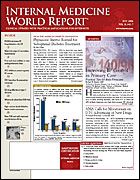Publication
Article
Internal Medicine World Report
Vardenafil Effective for ED in Men with Type 1 Diabetes
Author(s):
WASHINGTON, DC—It has long been shown that men with diabetes often have erectile dysfunction (ED). But for the first time, a study has rigorously evaluated the use of a phosphodiesterase type 5 (PDE-5) inhibitor in men with type 1 diabetes, investigators reported at the 66th Scientific Sessions of the American Diabetes Association.
Hermann Van Ahlen, MD, professor of urology, University of Muenster, Muenster, Germany, reported results in 273 men who had been randomized to 12 weeks’ treatment with vardenafil (Levitra), 10 mg (or 5 mg in men aged ≥65 years), or placebo following a 4-week, treatment-free, run-in period. Patients had the option to titrate downward to 5 or upward to 20 mg after each 4-week interval.
“Erectile dysfunction and diabetes often coexist, and more than 50% of men with diabetes develop ED within 10 years of diagnosis,” Dr Van Ahlen observed. “The prevalence of ED in­creased with age among men with diabetes, from 9% at 10 to 29 years of age, to 95% at age greater than 70 years.”
He continued, “Although an earlier trial had found that vardenafil is safe and effective in treating men with ED and diabetes, the patient population with type 1 diabetes was too small for analysis.”
Men in this study were aged ≥18 years, were in heterosexual relationships, had established type 1 diabetes and ED for at least 6 months, and had never used PDE-5 inhibitor therapy.
The primary efficacy end points were the success of vaginal insertion based on a positive response to the Sexual Encounter Profile question 2 (SEP2): “Were you able to insert your penis into your partner’s vagina?” and the success of maintenance of erection until completion of intercourse based on SEP question 3: “Did your erection last long enough for you to have successful ­intercourse?”
Vardenafil therapy significantly im­proved SEP2 from 41% at baseline to 70% at the end of the trial compared with 47% and 49% for placebo, respectively. Vardenafil also improved SEP3 from 13% at baseline to 51% at the end of the study. The corresponding results for placebo were 18% and 26%, respectively.
Vardenafil was effective regardless of baseline levels of glycemic control.
The treatment was safe and well tolerated, with mostly mild-to-moderate side effects. Headache, flushing, and nausea were the most frequent effects noted with vardenafil.
Dr Van Ahlen emphasized that although the study specifically demonstrated the clinical superiority of vardenafil over placebo in men with ED and type 1 diabetes, he postulates that the medication’s efficacy is likely a class effect.





